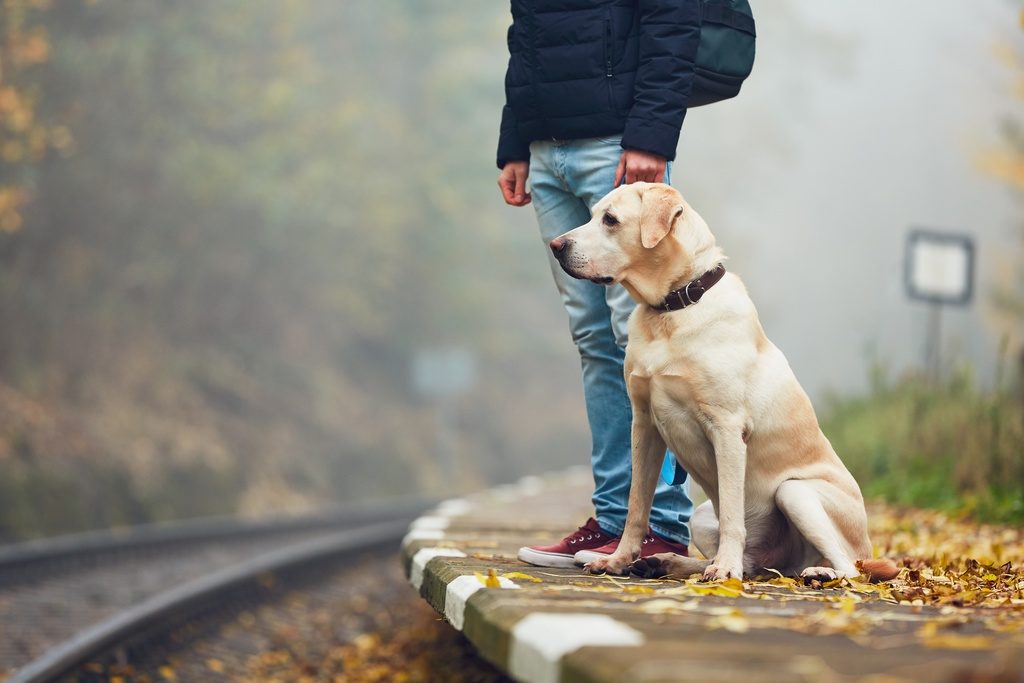
It is important that you take the time and effort to teach your dog some simple instructions for a number of important reasons:
• For your dog’s own safety,
• To stop unwanted and unruly behaviour,
• To reinforce your dog’s trust in you as pack leader.
Remember that your dog is a social animal and needs interaction with you to help support the bond with you as his best friend. Dogs are pack animals. Historically, discipline was taught and enforced by the pack leader. You are his best friend and his pack leader.
Although you will be teaching your dog to obey your instructions, if done correctly your dog will regard the lessons as play time. Forceful coercion will be counterproductive as that instruction will no longer be considered play and the whole bonding process between you and your dog will be damaged.
Whatever his age, your dog will enjoy learning. Dogs, like humans continue to enjoy play as adults. Obeying your instructions will be enjoyable and form part of that play. Continuous learning will also help stimulate your dog’s mind and avoid boredom. Bored dogs may misbehave and cause mischief.
Whether your dog is young or old, small or large, you will be able to teach him some instructions to obey. Unless he has already mastered “Sit”, “Stay”, “Come” and “Down”, these should be taught first. Then go for something he may already do, but not under your instruction. For example, if he will pick up a ball that has been thrown, say “Fetch” as he begins to run towards it. When he picks up the ball, give praise and a reward. Your dog will quickly associate the word “Fetch” with picking up an object thrown for him and a new instruction will have been learnt.
Once the eleven essential instructions have been mastered, any number of Fun Tricks can be taught.
Training Tips
There are a multitude of training techniques and the instructions here don’t claim to be definitive, or any better, but they may be helpful.
Try to break up each instruction into small steps and praise and reward as each step is accomplished.
Around five minutes is long enough for your dog to concentrate on any one activity. To keep his interest, switch to play something different. This will retain his interest in interacting with you and his willingness to pick-up where you left off another time.
Verbal encouragement is essential and should be consistent. Dogs are sensitive to voice tone and so always use the same light, upbeat tone for encouraging positive behaviour and to speed things up. A low, slow tone should be used when your dog is getting things wrong, or when you need to calm him down.
Verbal instructions must be simple and if possible reduced to one word. Additional words, or variations are likely to cause confusion both during training and later, when giving your dog an instruction. For example, a simple instruction “Fetch” can be taught to apply to any object that you have thrown. If later, you were to give the instruction, “Fetch the ball” your dog will be likely to interpret that command as a completely new instruction that has not yet been learnt.
Reward Treats: Always hold a reward treat in your hand before the beginning of each instruction you wish to teach. Immediately reward your dog verbally and give the treat as soon as the instruction has been accomplished.
If things aren’t going well, or if your dog appears to be becoming bored, take a break.
The Eleven Essential Instructions
There are four basic Instructions that every dog should learn first and these are “Sit”, “Stay”, “Come”, and “Down”. They are covered in Part One. In Part Two, retrieving games are covered using the commands, “Take”, “Give”, “Fetch” and “Drop” Once mastered, playtime with your dog will be more fun and will enable you to introduce the important instructions, “Give” and “Drop”.
“Give”and “Drop” are particularly important instructions that will enable you to keep your dog safe in the event that he has picked up something that may harm him.
In Part Three, instructions for calming behaviour are covered. These are important for your dog’s safety and will also stop unwanted behaviour when around other people. The commands are “Stop”, “Back-off” and “Bed”.
Part Four covers a technique to discourage unwanted barking and may not apply to your dog.
Once these essential instructions have been mastered, Fun Tricks can be taught. When teaching Fun Tricks, it is important to bear in mind that all dogs are different. Older dogs may have back, or hip problems, or are stiff in their joints. Instructions that involve jumping or crawling should be avoided. Jumping may put a strain on the joints of young dogs and puppies. Instructions that involve jumping are better deferred until adulthood.
Size and general fitness may mean that your dog will feel uncomfortable following certain instructions. You should never assume that your dog is being obstinate. If your dog is normally eager to learn in order to gain your attention and a reward, then that particular instruction may be unsuitable for some reason. Try something else.
It’s always worth giving some thought to the instruction that you are about to teach your dog. Will the new Fun Trick encourage behaviour that will be unacceptable when the instruction has been learnt? Only teach things that you will be happy for your dog to do when you’re not around.
For instructions to hunt for, or to bring objects to you, use toys made specifically for dogs. Always use a size of toy suitable for your dog and if he is an enthusiastic chewer, one that will not disintegrate.
Part One: The Four Basic Instructions
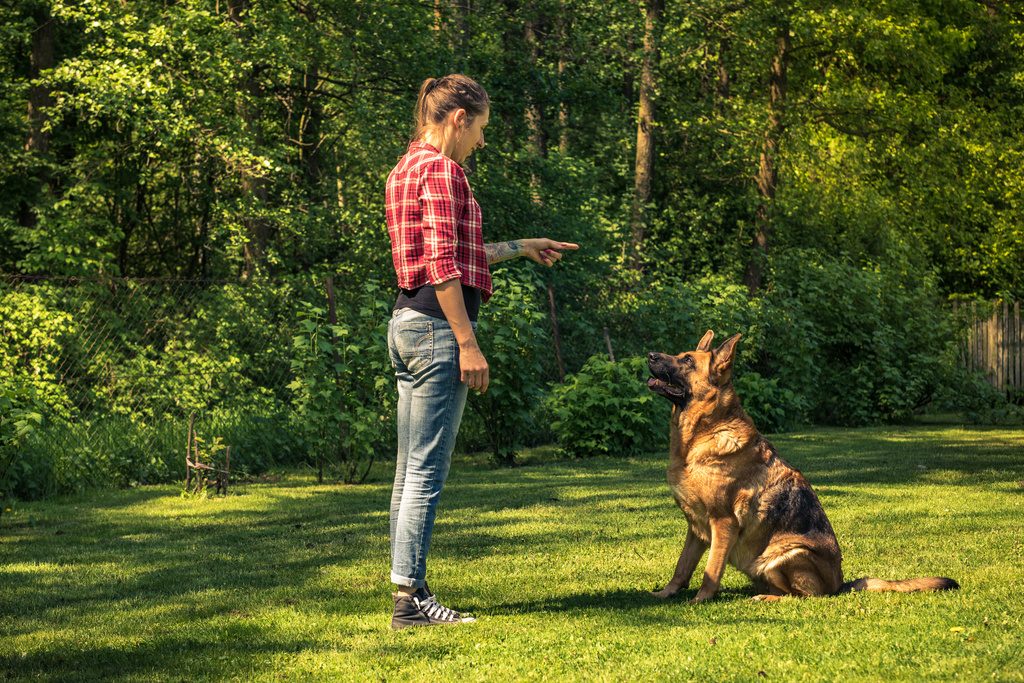
Before teaching your dog to obey more complex instructions, he must have mastered the four basic commands of “Sit”, “Stay”, “Come”, and “Down”. It is always worthwhile spending a few minutes of each training session practicing these instructions.
“Sit”
Place the reward treat in your hand so that it is visible.
Stand in front of your dog and raise the hand holding the treat. Your dog’s nose will follow the movement of the treat and his bottom will begin to lower. At this point, move your hand forward and over your dog’s head and as he goes into a sitting position, say “Sit” in a low, slow tone. Give him, the treat and verbal praise.
“Stay”
Place the reward treat in your hand so that it is visible. As with “sit”, the instruction for this trick should be given in a low, slow tone.
Give the instruction, “Sit”. Then, instead of rewarding this action step back two paces saying “Stay” in a low and calm voice. At the beginning, it’s likely that your dog will only stay still for a few seconds before moving towards you. Give the instruction to “Sit” again and repeat, stepping back two paces saying, “Stay”.
Repeat the exercise of “Sit” and “Stay” until your dog stays still long enough for you to step forward and reward him. As your dog’s understanding of what you want him to do increases, make him sit for slightly longer each time before he is rewarded.
“Come”
When your dog’s understanding of the instruction, “Stay” has increased to the point where you will have time to take a few steps further back before returning with the reward, you can introduce the instruction, “Come”.
Place the reward treat in your hand so that it is visible. In contrast with the two previous instructions, “Sit and “Stay”, the instruction, “Come” should be given in a light, encouraging and upbeat tone. Reward and praise should be given as soon as your dog has come to you when instructed.
“Down”
As with the instruction, “Stay” this command is best accomplished with your dog in a sitting position and with the instruction given in a low, calm tone. Place the reward treat in your hand so that it is visible.
Kneel down in front of your dog. In doing so, it is important that you don’t encroach into your dog’s body space by leaning over him. Give the instruction, “Down” and at the same time, move the hand holding the treat down and away from him. As he lowers himself to try to reach the treat, say “Down” slowly and calmly. Give the treat and praise as soon as he is lying down fully.
Remember that these four basic instructions are worth practicing for a few minutes before each training session. Repetition is the key to maintaining your dog’s understanding of your instructions and will reinforce your position as ‘leader of the pack’.
Retrieving games using the commands, “Take”, “Give”, “Fetch” and “Drop” will make playtime with your dog more fun and enable you to introduce the important instructions, “Give” and “Drop”.
“Give”and “Drop” are particularly important instructions that will enable you to keep your dog safe in the event that he has picked up something that may harm him.
Part Two: Retrieving Games “Take”, “Give”, “Fetch” and “Drop”
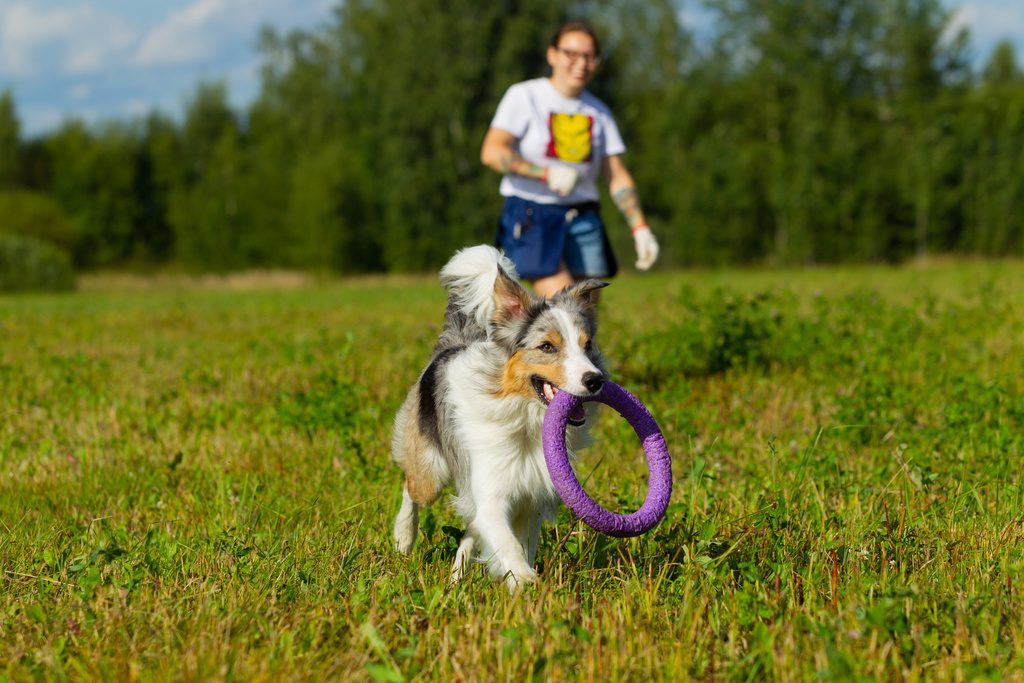
“Take” and “Give” are instructions that are best taught together. When teaching “Take” and “Give”, your dog will be in close proximity, so your instructions should be in a low and calm voice. Remember not to stand over your dog and encroach on his personal space.
Initially, your dog will learn to “Take” an object from your hand, but later to pick up an object from the floor. “Give” is especially important in the event that your dog has randomly picked up something which may harm him.
You will be able to focus your dog’s attention when teaching “Take” and “Give” by using one of his favourite toys, one that he has often held in his mouth.
To start, instruct your dog to “Sit”. Hold the toy near to him and say “Take”. As soon as he has the toy in his mouth, praise him. He should remain sitting and after a few moments say “Give” and take the toy away from him. Give him a treat in exchange. Do not give a treat if he drops the toy before you have taken it.
Once your dog has learned to take that particular toy from your hand and return it, you can move on to getting him to understand that the instruction is an action and does not refer to that particular toy. Choose another toy and repeat the exercise. Once this has been mastered, use other toys until he fully understands that “Take” and “Give” refer to his actions and not to any specific object.
The next step is to teach your dog to pick up a toy from the floor. If he has fully understood the trick of taking an object from your hand, it won’t matter which toy you use, but its shape and size must be easy for him to grasp from the floor with his mouth.
Instruct your dog to “Sit”. Place the toy close beside you on the floor and say “Take” while looking at it. Praise him for picking it up and then say “Give”. Take the toy and praise and reward him.
As he begins to fully understand the idea of picking up from the floor and giving back to you, place the toy slightly further away from you. Be careful not to confuse him by throwing the toy – this is “Fetch” – a completely different instruction.
Once your dog can pick up any object on your instruction, you can encourage your dog to “Take” and go with you somewhere else before you say “Give”. (It is usually helpful at this stage to introduce the instruction “Sit” prior to saying “Give” in order to remain in full control.) For example, if you are about to go outside with a ball to play “Fetch”, instruct your dog to “Take” the ball from your hand, or the floor and walk outside before giving the instructions “Sit” and “Give”. If your dog begins to associate play with your instructions, this will reinforce his understanding and willingness to comply.
“Fetch”
Not all dogs will instinctively run to pick-up an object thrown for them. Some breeds will need to be taught. Also, some dogs may immediately run to pick-up an object, but then wander off with it. For some dogs, “Fetch” may need to be broken down into two distinct parts. Depending on the responses from your dog to your instructions, you may need to teach “Fetch” (to pick-up the object thrown) and then give a further instruction, “Come”, (to bring the object to you).
The instruction, “Fetch” should be given in a light, upbeat tone.
If your dog will automatically pick-up something that you have thrown, always give the instruction, “Fetch” as soon as he starts to move towards that object. Although your dog may always retrieve an object that you have thrown and return to you, always give the instruction “Fetch”. This will further reinforce the idea that you are in control and that his actions are under your command.
For dogs that are reluctant to pick-up an object that you have thrown, or do not appear to understand what is required of them, use your dog’s favourite toy. Repeat the exercise several times and on different occasions, so as not to bore your dog. As soon as your dog does pick-up the object as instructed, lavish enormous praise and a treat. In order to teach him to bring the object to you, you should use the “Come” instruction that he has already been taught. In this case, it is important to start at the beginning to ensure that you dog will link the two instructions. Throw the object and say “Fetch” in a clear and up-beat tone. As soon as your dog has the object in his mouth, give the instruction, “Come”, again in a clear and up-beat tone. Reward and praise will need to be deferred until the completion of both instructions.
“Drop”
Teaching this command is important if your dog is reluctant to let go of the object once he has returned it to you. It will also be helpful in the event that your dog has picked up an object that is potentially dangerous, or that does not belong to you.
Use a low and calm tone of voice for this instruction
Even if your dog normally drops an object when he returns to you, you should still give the instruction “Drop” and praise him for doing so. This will further reinforce the idea that you are in control and that his actions are under your command.
If the “Drop” instruction needs to be taught, you may find it helpful to use the instruction, “Sit” prior to the instruction, “Drop”. The sequence might then be:
“Fetch” as your dog starts to move towards the object you have thrown,
“Come” as soon as your dog has the object in his mouth – both of these instructions in a light and up-beat tone
“Sit” once your dog has returned to you, and
“Drop” as soon as he is sitting – these last two instructions should be in a low and calm tone.
As soon as the object has been dropped, offer the treat and lavish praise.
Sometimes a dog may be reluctant to drop his toy. Often, this can be remedied by placing your hand under his jaw and giving the instruction, “Drop” as you remove the toy from his mouth. Immediately give the toy back. Your dog will learn that he will not permanently lose his toy when he obeys you. Again, praise and give a treat reward for satisfactory completion of your instructions.
Continual repetition enforces his understanding of your instructions, but remember not to let him get bored with the game.
The objects that you throw for your dog to retrieve must be safe. Toys specifically designed for dogs are best. Also take account of your dog’s size. Balls, or other toys that are too small may cause choking in the excitement of the game.
Part Three: Calming Instructions
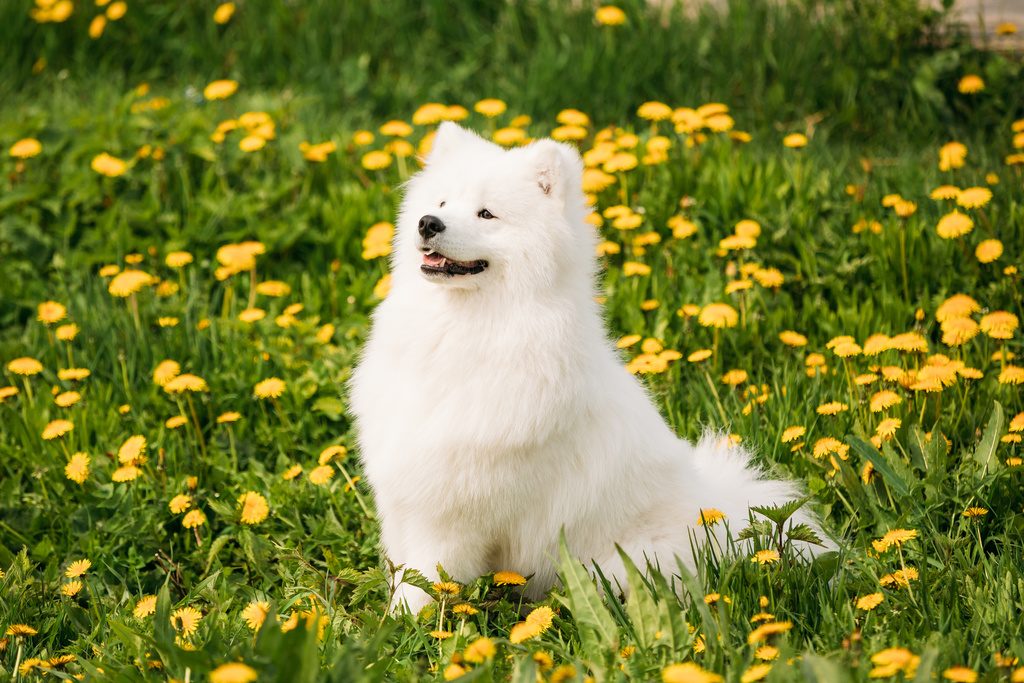
Instructions for calming behaviour are important for your dog’s safety and will also stop unwanted behaviour when around other people. These commands are “Stop”, “Back-off” and “Bed”
“Stop”
It is important to teach your dog to stop. An enthusiastic and boisterous dog must learn to calm down when you have decided that play has finished. If your dog is ignoring you and continues to run around after playtime has finished, chasing him to try to gain control will encourage your dog to continue as he will assume that this is a new game that you want to play.
Training your dog to respond instantly to your stop instruction will take time and patience. The instruction must be repeated regularly, daily if possible and at times when your dog is excited and wanting to continue to play and at times when he is calm.
Your tone of voice, when giving the stop instruction must be low and calm. Shouting may gain your dog’s attention, but will not get the response you want.
A signal is used with the “Stop” instruction. It is important to stand still and extend your arm towards your dog, the back of your hand pointing to your dog, fingers pointing to the ground. In a low and calm voice say “Stop”. You should remain still and repeat the instruction “Stop” in an even lower voice if the first instruction has been ignored.
Once you have your dog’s attention, give him the instruction “Sit”. As soon as your dog is calm and sitting, you should approach giving praise and a treat reward.
Initially, when practicing the “Stop” instruction it will become obvious that when your dog is excited there may be little, or no response. The value of successfully teaching your dog to stop on your instruction is so great that the constant practice necessary will be well worthwhile. Practicing when he is calm and when he is playing will gradually get the result you want. Always praise and reward with a treat, those occasions when your dog responds correctly.
“Back-off”
Training you dog to respond instantly to this instruction will have huge benefits in difficult situations. You will be able to gain full control and attach a lead if necessary. The “Back-off” instruction would prove invaluable in calming a potentially serious situation such as if your dog were being too boisterous with a small child, or jumping up at someone.
As with the “Stop” instruction, your voice tone should be low and calm. There is a signal for this instruction also. You should extend your arm towards your dog, this time palm facing. When giving the “Stop” instruction, it is important to stand still. For the instruction, “Back-off” you should be moving gently towards your dog to enable you to take hold of the collar, or attach a lead if required. To assist with this, the instruction to ”Sit” would be the immediate follow-up instruction once you had your dog’s attention. Once you have full control, give praise and a reward treat.
Clearly, if you have needed to give the “Back-off” instruction, your dog will be in a very excitable mood and will want to continue with what he was doing. Give him a toy, or something pleasurable to do as a distraction. It is much easier for your dog to understand that you want him to do something different and pleasant than just to stop what he was clearly enjoying.
Training your dog to respond instantly to “Back-off” will take practice and patience. As with “Stop”, the instruction must be repeated regularly, daily if possible and at times when your dog is excited and at times when he is calm.
“Bed”
The instruction, “Bed” is invaluable for taking control and calming your dog when at home. This instruction will teach your dog that he must understand that from time to time you need him to go somewhere specific to lie down and be quiet.
The instruction, “Bed” will be particularly useful if you have visitors who are unused to, or may be a little apprehensive of dogs. By demonstrating your control, you will immediately gain their confidence that you have a well trained dog and that any anxieties that they had were probably unfounded.
“Bed” is an extremely easy instruction to teach if you choose your training opportunities well. Most dogs will have a favourite place to settle and rest, or somewhere where they always sleep. After an energetic playtime, or a long walk, your dog is likely to want to take a rest. As he begins to walk towards his resting spot, point to it and say calmly, “Bed”.
If, after a number of occasions your dog still fails to make the connection between your verbal instruction and his resting place, tap the place where you want him to settle down and give the instruction, “Bed”. Because he already wants to lie down there, the verbal instruction and the understanding will quickly fall into place. Remember to give him praise and a treat reward as soon as he lies down and then leave him alone.
With continuous practice, your dog will learn that on your instruction, “Bed”, he should stop what he is doing and go quietly to his resting spot and lie down, whether he wants to or not.
Once these essential instructions have been mastered, Fun Tricks can be taught. When teaching Fun Tricks, it is important to bear in mind the age, size and general fitness of your dog.
It’s also always worth giving some thought to the Fun Trick that you are about to teach your dog. Will the new Fun Trick encourage behaviour that will be unacceptable when the instruction has been learnt? Only teach things that you will be happy for your dog to do when you’re not around.
Part Four: Instruction to Discourage Unwanted Barking.
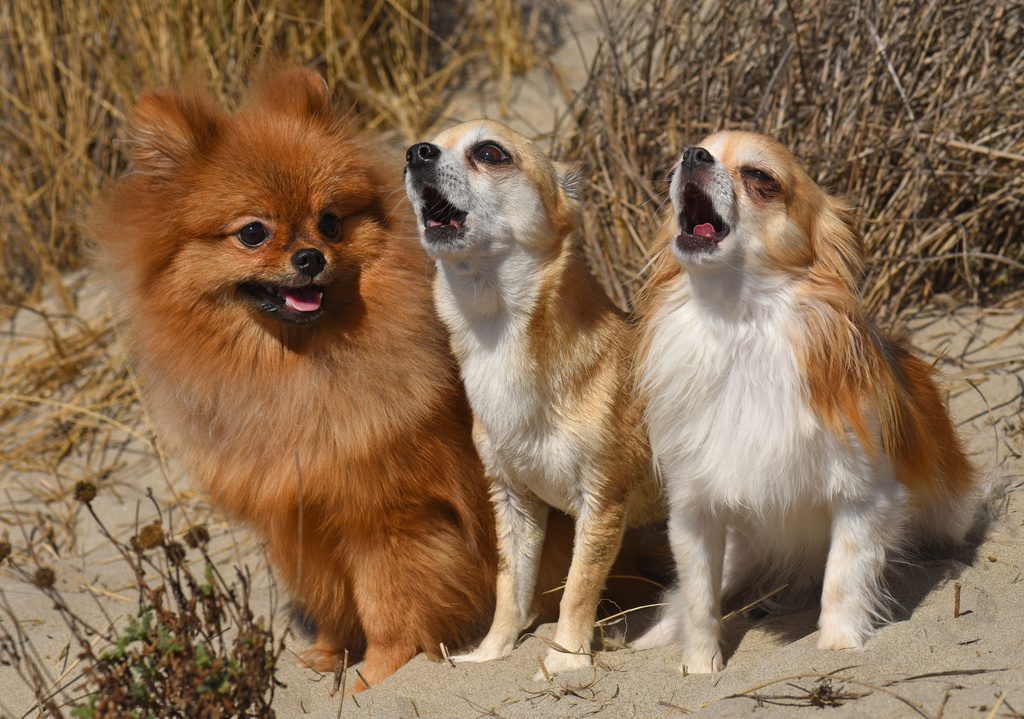
The purpose of teaching this command is to get your dog to understand that he should only bark when you want him to, not just because he wants to. (If you have a dog that doesn’t bark when someone arrives at your house, then you won’t need to teach this.) Eventually, your dog will learn to bark only when you give the instruction to “Answer the Door” and the problem of annoying barking at other times will eventually stop.
It is important that you have already taught your dog the instruction “Stop”.
The instruction to “Answer the Door” can really only be taught when the opportunity occurs. Watch out for the moment your dog is about to bark when someone arrives at the door. In an encouraging voice, say “Answer the door” and run to the door with him. As soon as you both arrive at the door, say “Stop” in a low and calm voice and remember to use the hand signal with your arm extended, the back of your hand facing your dog and your fingers pointing down. As soon as your dog stops barking, give him enormous praise and a treat if you have one. Repeat the exercise as often as possible until your dog stops barking immediately on hearing your “Stop” instruction.
It is helpful to give a follow-up instruction to “Sit” in order to further distract him from starting to bark again.
Practicing “Answer the Door” whenever possible will reinforce his understanding that it is acceptable for him to bark, but only when you give the instruction “Answer the Door”.
Also, practice the “Stop” instruction whenever your dog barks. Once mastered, your dog will the learn that he should stop barking whenever you give the instruction “Stop”.
Eventually, your dog will learn to bark only when you give the instruction to “Answer the Door” and the problem of annoying barking at other times will eventually stop.
